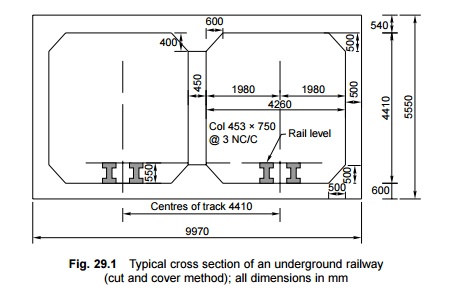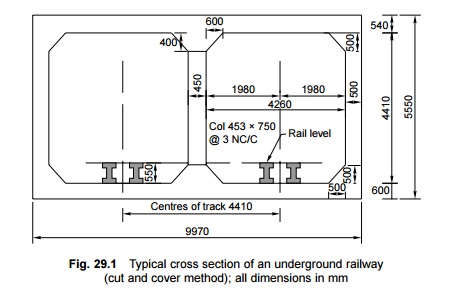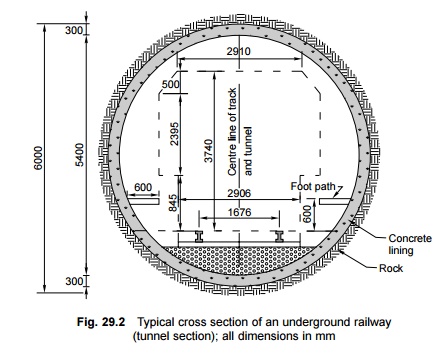Chapter: Civil : Railway Airport Harbour Engineering : Railway Engineering : Suburban Railways in Metro Cities
Underground Railways

Underground Railways
In such a system, the railway line is constructed below the ground level. The requisite construction work is done mostly by the 'cut and cover method'. The area is excavated in the shape of trenches and once the formation is ready, the track is laid, the necessary overhead structures are provided, and finally the trenches are covered and the ground is restored to its original state.
An underground railway system normally uses 'electric traction', as steam and diesel tractions produce smoke and lead to the pollution of the environment, which in this case becomes particularly hazardous since these railways are underground. Proper arrangements are also made for the drainage of underground railways as the low-lying areas in which they are constructed are likely to get flooded during the rains. Such underground railways have been constructed in Kolkata and Delhi and in other countries around the world.
The main advantages and limitations of underground railways are as follows.
Advantages
(a) Trains can run fast and unobstructed in an underground railway system as there are no road crossings or other similar problems.
(b) As the trains move at incredible speeds, underground railways can deal with a very high concentration of human traffic.
(c) There is no wastage of land and a large area of the city, which would have otherwise been used for surface railways, remains available for other utilities.
(d) Provides safety from aerial attacks, particularly during war.
Limitations
(a) The underground railway system is a very costly arrangement and a heavy financial backing is required. The cost may vary anywhere from Rs 30 million to 100 million per km, depending upon the geographical features and other conditions.
(b) Special attention needs to be given to the drainage as well as proper ventilation of underground railways.
(c) During construction, the residents of the city are greatly inconvenienced as excavation work is normally carried out throughout the city. The water supply, electricity supply, and sewerage system of the city are also affected, as the diversion of many of these services is required during the constructional phase.
Cross section of an underground railway
An underground railway may have either one of the following cross sections depending upon the method used in its construction.
Cut and cover In this case, excavation is done by the cut and cover method. This method affects all public services such as water supply, sewerage mains and electric and telephone lines, which have to be diverted or suspended temporarily. The typical cross section of an underground railway constructed using the cut and cover method is given in Fig. 29.1.

Tunnel section The tunnel for the underground railway is dug very deep into the ground, much below the level at which the ground is dug for water and sewerage mains and for telephone and electric lines. The circular cross section of the tunnel is sometimes made by the application of modern techniques that involve pushing a big pipe of an adequate size through the ground. The necessary infrastructure is then provided within this circular tunnel. The typical cross section of such an arrangement is shown in Fig. 29.2.

Related Topics